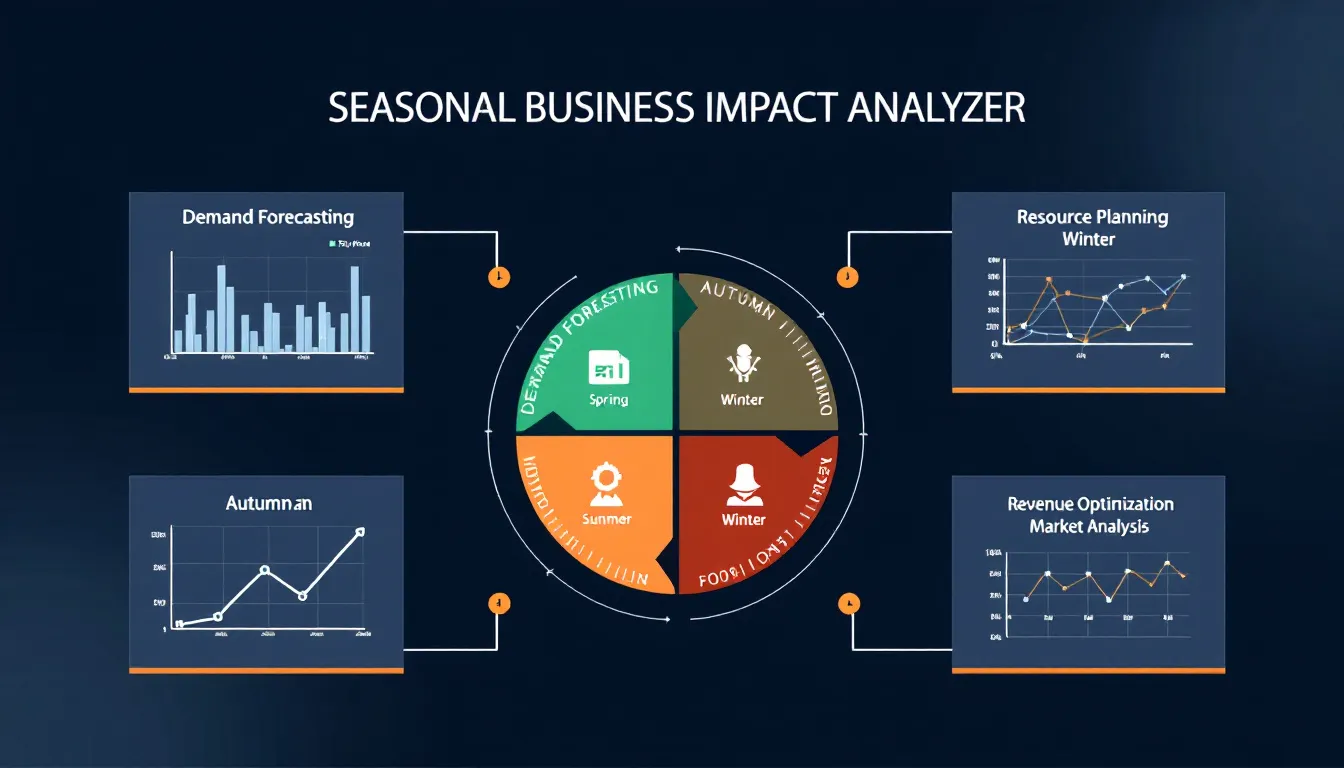Is this tool helpful?
How to Use the Seasonal Business Impact Analysis Tool Effectively
This tool helps you analyze how seasonal trends affect your business by gathering important information across several fields. Here’s how to use each input effectively with examples:
- Business Name: Enter your official business or trading name. Examples: “Lakeside Coffee Roasters” or “Urban Fitness Gym”.
- Industry/Sector: Choose the category that best fits your business. Examples: “Food & Beverage” or “Health & Wellness”.
- Main Products/Services: Describe your key offerings in detail. Examples: “Specialty coffee blends, brewing equipment, subscription services” or “Personal training, group classes, nutrition coaching”.
- Seasonal Events: Detail events or seasonal patterns that impact your sales or operations. Examples: “Holiday shopping surge, summer music festivals” or “January New Year fitness rush, summer vacation slowdowns”.
- Current Challenges (Optional): Share any specific issues affecting your business now. Examples: “Managing staff availability during holidays” or “Supply delays due to weather disruptions”.
What Is the Seasonal Business Impact Analysis Tool?
The Seasonal Business Impact Analysis Tool helps you understand how different times of the year influence your business performance. It gathers your business data and seasonal factors to identify trends and opportunities. Using this tool improves your ability to plan inventory, allocate resources, manage staff, and time marketing campaigns effectively.
By analyzing seasonal variations in demand and sales, you reduce risks like stock shortages or overstocking and capitalize on peak periods. This results in smoother operations, better customer satisfaction, and stronger cash flow management.
Key Benefits of the Tool
- Accurately forecast seasonal demand to optimize stock levels
- Improve workforce planning to meet peak and off-peak needs
- Identify key seasons for targeted marketing and promotions
- Reduce waste and enhance operational efficiency
- Support strategic business decisions with actionable insights
Practical Uses of the Tool
This tool is designed as an API-driven form that processes your inputs to generate tailored seasonal impact insights. It helps you apply data-driven decisions based on your unique business scenario and seasonal variables.
Retail Business Example
Imagine a specialty bakery analyzing its seasonal patterns:
- Winter holidays: 50% sales increase on specialty cakes
- Spring festivals: 30% foot traffic growth
- Summer vacation months: 20% decline in daily orders
- Fall harvest season: 40% increase in bulk orders
Using the tool’s analysis, the bakery adjusts inventory orders, schedules extra staff before holidays, and plans marketing promotions around meal celebrations.
Service Industry Use Case
A community yoga studio tracks seasonal attendance trends:
- New Year resolutions: Class attendance peaks in January and February
- Summer months: Lower attendance due to vacations
- Autumn: Stable attendance with increased workshop bookings
- Holiday season: Drop in regular class participation
They use these insights to schedule workshops in the fall, increase marketing early in the year, and offer promotions during slow summer months.
Key Components in Seasonal Business Analysis
- Demand Pattern Recognition: Identify when customer purchases increase or decrease based on seasons.
- Resource Allocation: Plan inventory, staff, and capital expenditure around peak and slow periods.
- Revenue Forecasting: Estimate future income factoring seasonal trends.
- Inventory Management: Balance stock levels to avoid shortages or excess.
- Staffing Optimization: Align workforce needs with seasonal customer demand.
Seasonal Demand Forecasting Formula
The core formula to estimate seasonal demand is:
$$ SF = (HPD \times ST) + (MA \times SF) $$- SF: Seasonal Forecast
- HPD: Historical Pattern Data
- ST: Seasonal Trend
- MA: Market Adjustment
Seasonal Revenue Optimization Model
To optimize revenue around seasonal patterns, the model is:
$$ SRO = \big[(BR \times SP) \times SV\big] + SA $$- SRO: Seasonal Revenue Optimization
- BR: Base Revenue
- SP: Seasonal Pattern
- SV: Seasonal Variance
- SA: Seasonal Adjustment
Implementing Seasonal Insights into Your Business Strategy
Short-Term Adjustments
- Adjust inventory weekly based on recent sales data
- Optimize daily staffing schedules to match customer peaks
- Update pricing dynamically during high and low demand periods
- React quickly to seasonal marketing opportunities
Long-Term Planning
- Create annual sales and resource allocation plans centered on seasonal trends
- Develop timelines for seasonal promotions and product launches
- Plan capital investments around known demand cycles
- Schedule large marketing campaigns to coincide with peak seasons
Best Practices for Seasonal Business Analysis
- Update your business data regularly to keep analysis accurate
- Monitor seasonal patterns consistently throughout the year
- Use the analysis to recognize emerging trends early
- Plan proactively rather than reactively to seasonal changes
- Integrate findings into your marketing, staffing, and inventory strategies
Frequently Asked Questions About Seasonal Business Impact Analysis
Which businesses gain the most from seasonal analysis?
Retailers, food service providers, tourism operators, agricultural businesses, and service industries benefit the most. Still, most businesses experience some form of seasonality that impacts sales and operations.
How often should I analyze my seasonal business impact?
Perform a detailed seasonal analysis quarterly. Track relevant metrics monthly to adjust plans quickly when needed.
Can seasonal analysis help me with staffing decisions?
Yes. You can plan workforce levels based on predicted busy and slow seasons, improving operational efficiency and employee satisfaction.
How does seasonal analysis improve inventory management?
It helps you align inventory levels with expected demand, reducing both overstock and stockouts, which lowers costs and improves customer experience.
Why is historical data important in seasonal analysis?
Historical data forms the foundation for identifying trends, predicting future patterns, and spotting anomalies requiring attention.
Can seasonal insights boost marketing effectiveness?
Absolutely. By knowing when your customers are most active, you can schedule targeted campaigns that maximize engagement and sales.
How does this analysis affect pricing strategies?
It enables you to implement dynamic pricing, increasing prices during peak demand and offering promotions during slower periods to maximize revenue.
Is seasonal business impact analysis useful for online businesses?
Yes, e-commerce platforms also experience seasonal fluctuations in traffic and sales. This analysis helps optimize your online store’s inventory, marketing, and staffing accordingly.
Important Disclaimer
The calculations, results, and content provided by our tools are not guaranteed to be accurate, complete, or reliable. Users are responsible for verifying and interpreting the results. Our content and tools may contain errors, biases, or inconsistencies. Do not enter personal data, sensitive information, or personally identifiable information in our web forms or tools. Such data entry violates our terms of service and may result in unauthorized disclosure to third parties. We reserve the right to save inputs and outputs from our tools for the purposes of error debugging, bias identification, and performance improvement. External companies providing AI models used in our tools may also save and process data in accordance with their own policies. By using our tools, you consent to this data collection and processing. We reserve the right to limit the usage of our tools based on current usability factors.







